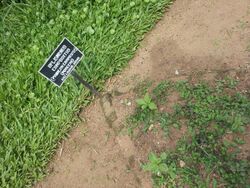Biology:Oplismenus compositus
| Oplismenus compositus | |
|---|---|

| |
| Scientific classification | |
| Kingdom: | Plantae |
| Clade: | Tracheophytes |
| Clade: | Angiosperms |
| Clade: | Monocots |
| Clade: | Commelinids |
| Order: | Poales |
| Family: | Poaceae |
| Subfamily: | Panicoideae |
| Genus: | Oplismenus |
| Species: | O. compositus
|
| Binomial name | |
| Oplismenus compositus | |
| Synonyms[1] | |
| |
Oplismenus compositus, the running mountaingrass, is a species of perennial plant from the family Poaceae that can be found throughout Asia (Pakistan [1] China ), Africa, Australia , South America, Mexico[2] and Hawaii.[3]
Description
The plant is 15–150 centimetres (5.9–59.1 in) long. The leaves are lanceolate, ovate, are 2–16 centimetres (0.79–6.30 in) long and 8–35 millimetres (0.31–1.38 in) wide. It leaf blades are [[Biology:Leaf#Venation (arrangement of the veins)|]] and have obscure cross veins with an apex which is acuminate or slightly acute. O. compositus have a raceme which is composed from inflorescence. It is borne on a side of central axis, is unilateral and is 2.5–11 centimetres (0.98–4.33 in) long. The central inflorescence axis 5–25 centimetres (2.0–9.8 in) long with angular rachis and is either glabrous or pilose on the bottom. Spikelets come in 2 rows which are fertile, pedicelled, and sessile. The pedicels are oblong. The spikelets also have one basal sterile florets and one fertile florets while its rhachilla is not extended. They are 2.5–4 millimetres (0.098–0.157 in) in length and are lanceolate.[2]
The glume is shorter than a spikelet and thinner than fertile lemma. It lower glume is ovate with its awn being 3–10 millimetres (0.12–0.39 in) in length. The upper glume is also ovate, but unlike the lower, is also herbaceous with glabrous surface which can be pubescent as well. It is also obtuse and is 0–4 millimetres (0.00–0.16 in) in length. Florets are 2–2.5 millimetres (0.079–0.098 in) in length and are pubescent, emarginate, and mucronate as well. Both florets and glumes are 1-keeled, but the veins are different; Glumes are 5 while florets are 7–11. The fruit is linear and is 0.5 millimetres (0.020 in) in length.[2]
References
- ↑ 1.0 1.1 "Oplismenus compositus". Flora of Pakistan. http://www.efloras.org/florataxon.aspx?flora_id=5&taxon_id=200025751.
- ↑ 2.0 2.1 2.2 "Oplismenus compositus". The Board of Trustees, Royal Botanic Gardens. Kew: GrassBase. http://www.kew.org/data/grasses-db/www/imp06755.htm.
- ↑ "Oplismenus compositus (L.) P. Beauv. Running Mountain Grass". USDA. PLANTS Profile. http://plants.usda.gov/java/profile?symbol=opco2.
External links
Wikidata ☰ Q13936837 entry
 |

